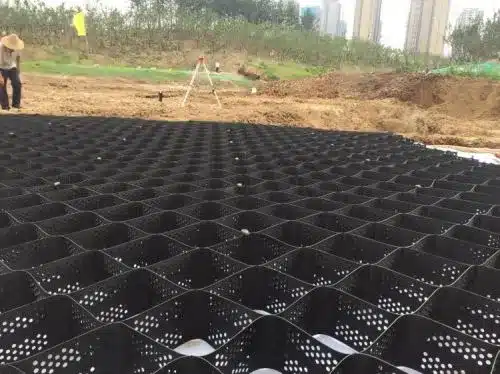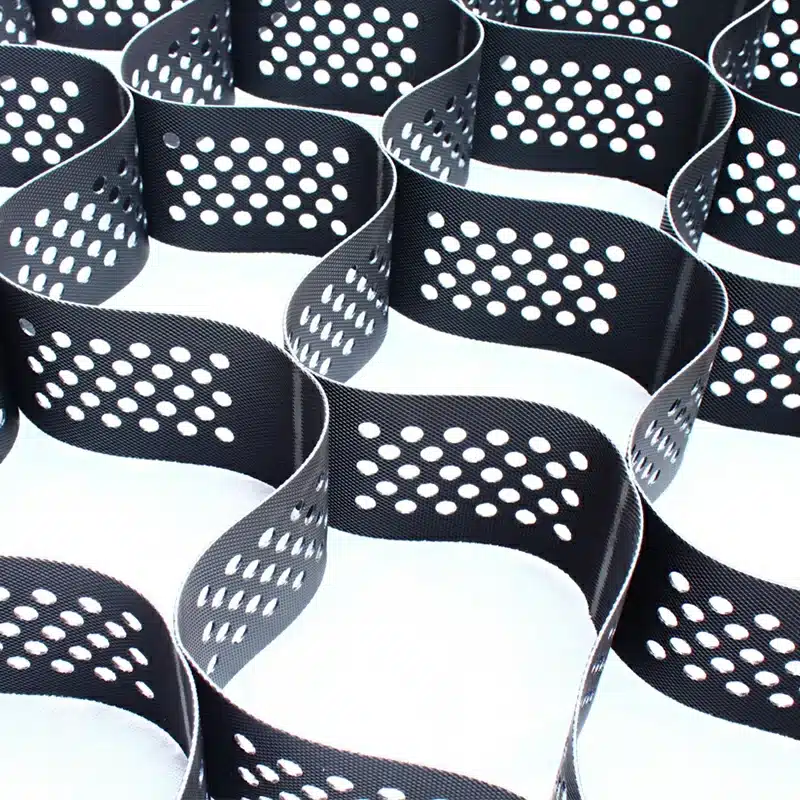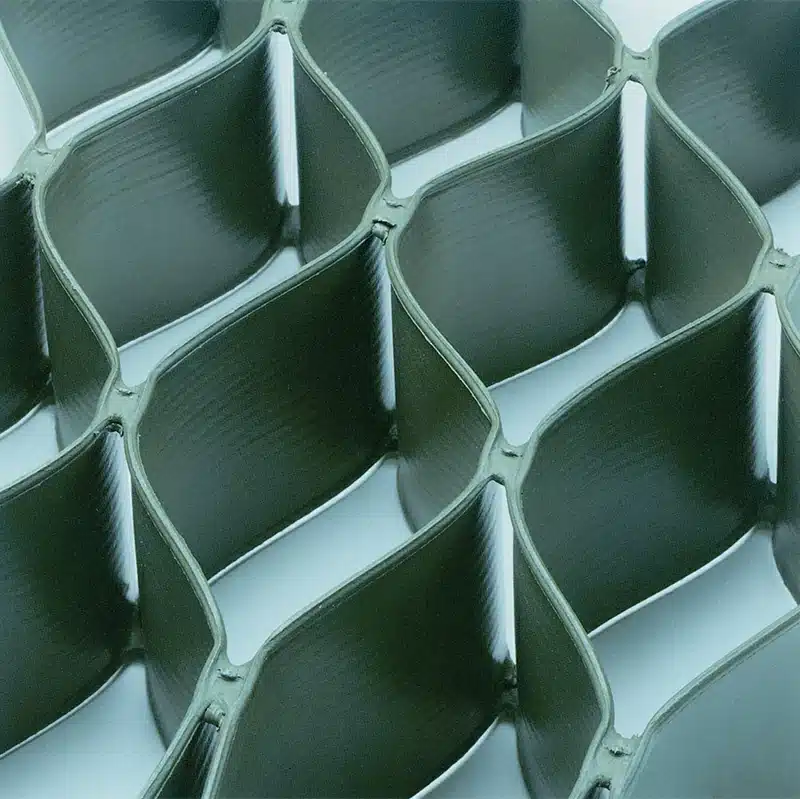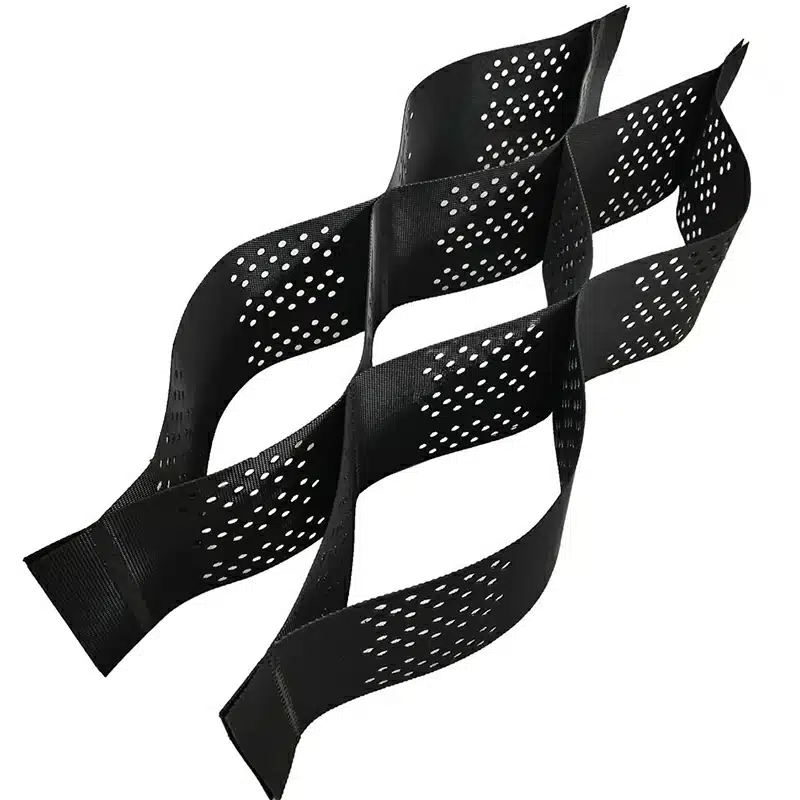+86-159 9860 6917
info@geofantex.com
geofantex@gmail.com
+86-400-8266163-44899
Geocell soil erosion control products have become essential for stabilizing slopes, preventing soil erosion, and enhancing the durability of various landscapes. These honeycomb-shaped, cell-like structures are filled with materials that reinforce soil on slopes and embankments, ensuring protection against erosion. Geocells are particularly valued in civil engineering and environmental protection projects due to their durability and ease of installation. Understanding the materials, filling requirements, and specific benefits of geocells helps clarify their role in controlling soil erosion.
What is the material of geocell?
Geocells are typically made of high-density polyethylene (HDPE) or polypropylene. These materials are chosen for their strength, durability, and resistance to environmental conditions such as UV degradation, corrosion, and chemical exposure. Geocells are used primarily in soil stabilization, erosion control, and load support applications, and their honeycomb-like structure enhances the performance of the material by allowing for the confinement of soil or aggregate.

What to fill geocell with?
Geocells are often used in erosion control projects to stabilize soil, prevent erosion, and provide structural support. Filling these geocells with the appropriate materials is crucial to achieve the desired performance. Below is a detailed guide on the best filling options, their benefits, and considerations.
Materials to Fill Geocells
Gravel and Crushed Stone
- Description: Gravel is one of the most commonly used materials to fill geocells. It allows for excellent drainage while providing solid support for soil on slopes.
- Benefits: Provides good compaction and drainage. The voids between gravel particles allow water to flow through, reducing the risk of erosion.
- Considerations: Ensure the gravel size is appropriate to avoid excessive movement within the geocell. Larger stone can lead to more stability but may hinder water flow.
Sand
- Description: Sand is a versatile material that works well for geocells, particularly in areas where soil stabilization is needed.
- Benefits: Offers adequate drainage and fills the geocells evenly, ensuring a stable surface. Sand can also be compacted to create a strong base.
- Considerations: Fine sand may clog drainage pathways. Ensure sand is coarse or medium-grained to balance drainage with stability.
Topsoil and Soil Mixtures
- Description: A mix of topsoil or natural soil can be used for areas where vegetation is intended to grow. This material provides a solid base for plants and vegetation roots.
- Benefits: Supports plant growth, making it ideal for environmentally sensitive areas where revegetation is part of the goal. Soil helps with erosion control and water retention.
- Considerations: May not be as effective in areas with poor drainage. It’s important to ensure proper compaction and mix it with coarse materials like sand or gravel if drainage is a concern.
Recycled Materials (e.g., Rubber Mulch or Recycled Concrete)
- Description: Recycled rubber or crushed concrete can be used for filling geocells in areas that require durable and environmentally friendly solutions.
- Benefits: Rubber mulch can help prevent erosion and can be particularly useful in urban or high-traffic areas. Crushed concrete provides durability while reducing waste.
- Considerations: Ensure that recycled materials are clean and free from contaminants. These options may have limited plant growth support.
Wood Chips or Mulch
- Description: Organic materials like wood chips or mulch are good for enhancing vegetation growth in geocell applications.
- Benefits: In addition to preventing soil erosion, these materials decompose over time and contribute to soil fertility. They also provide a soft surface for areas prone to foot traffic.
- Considerations: May decompose too quickly in wet environments. It may require replenishing periodically.
Gravel-Sand Mixture
- Description: A combination of gravel and sand can provide the best of both worlds, balancing compaction and drainage.
- Benefits: Enhances drainage while maintaining stability, especially in areas with moderate to high water flow. It also offers greater flexibility in terms of load-bearing capacity.
- Considerations: Proper mixing is essential to avoid clogging of the voids.
Best Practices for Filling Geocells
- Layering Materials: For optimal performance, especially in erosion-prone areas, it’s advisable to layer materials. Start with coarser materials like gravel or crushed stone at the bottom for drainage. Then, top with finer materials like sand or topsoil for plant growth.
- Compaction: Proper compaction of materials is essential to ensure the geocells maintain structural integrity and support soil stability. Use mechanical equipment to compact heavier materials such as gravel or crushed stone, but avoid compacting soil too much as it can hinder plant growth.
- Environmental Considerations: Be mindful of the environmental impact of the materials you choose. Recycled materials like rubber mulch or crushed concrete may help reduce environmental harm. If vegetation is part of your project, ensure the topsoil is compatible with the plant species you intend to grow.
- Drainage Needs: Ensure that the selected material does not hinder water movement within the geocell structure. For areas with high water runoff, using a gravel-sand mixture can improve both drainage and soil stability.
- Maintenance: Regular maintenance is necessary to ensure that the materials within the geocells remain stable over time. Organic materials like mulch may require periodic replenishment, while gravel and stone fillings need to be checked for displacement or erosion.
By carefully selecting and layering materials, you can maximize the geocell’s effectiveness in enhancing soil stability and controlling erosion in sloped areas.
What is slope protection with geocells?
Slope protection with geocells involves deploying geocell structures on inclined surfaces to prevent soil erosion, maintain slope stability, and control sediment runoff. The geocell’s honeycomb structure confines the fill material, creating a stable layer that resists displacement even under heavy rainfall or erosion pressure and effectively controls erosion as the cells prevent movement of the infill. Geocells are particularly effective for stabilizing steep slopes and embankments, as they distribute loads evenly and help establish vegetation, further protecting against soil erosion. This method is commonly applied in road embankments, riverbanks, and other vulnerable terrains.
What are the benefits of geocells?
Geocells offer several key benefits for soil erosion control:
- Enhanced Soil Stability: The cellular confinement system prevents soil movement, helping maintain the integrity of slopes and embankments decrease unwanted runoff or groundwater flow, and stop the formation of erosion channels that threaten the landscape.
- Versatile Applications: Geocells can be used in various settings, from landscapes requiring vegetation support to high-stress applications needing gravel or concrete reinforcement.
- Eco-Friendly Solution: Geocells allow vegetation growth on slopes, integrating with the natural environment, improving long-term erosion resistance, and reducing the risk of erosion channels.
- Cost-Effective Installation: Compared to traditional erosion control methods, geocells are easy to install, reducing labor and equipment costs while providing a long-lasting solution.
- High Durability: Made from robust materials like HDPE, geocells are resistant to weather changes, UV exposure, and chemical reactions, ensuring a prolonged service life..
Geocell soil erosion control products are a reliable solution for stabilizing slopes and protecting against erosion. Constructed from durable materials like HDPE and filled with a range of supportive materials, geocells provide slope stability, promote vegetation growth, and enhance the durability of landscapes in various environments. With their ease of installation, adaptability, and long-term stability, geocells are an effective choice for environmental and civil engineering projects focused on sustainable erosion control.



Get Free Sample
We’ll respond as soon as possible(within 12 hours)






















